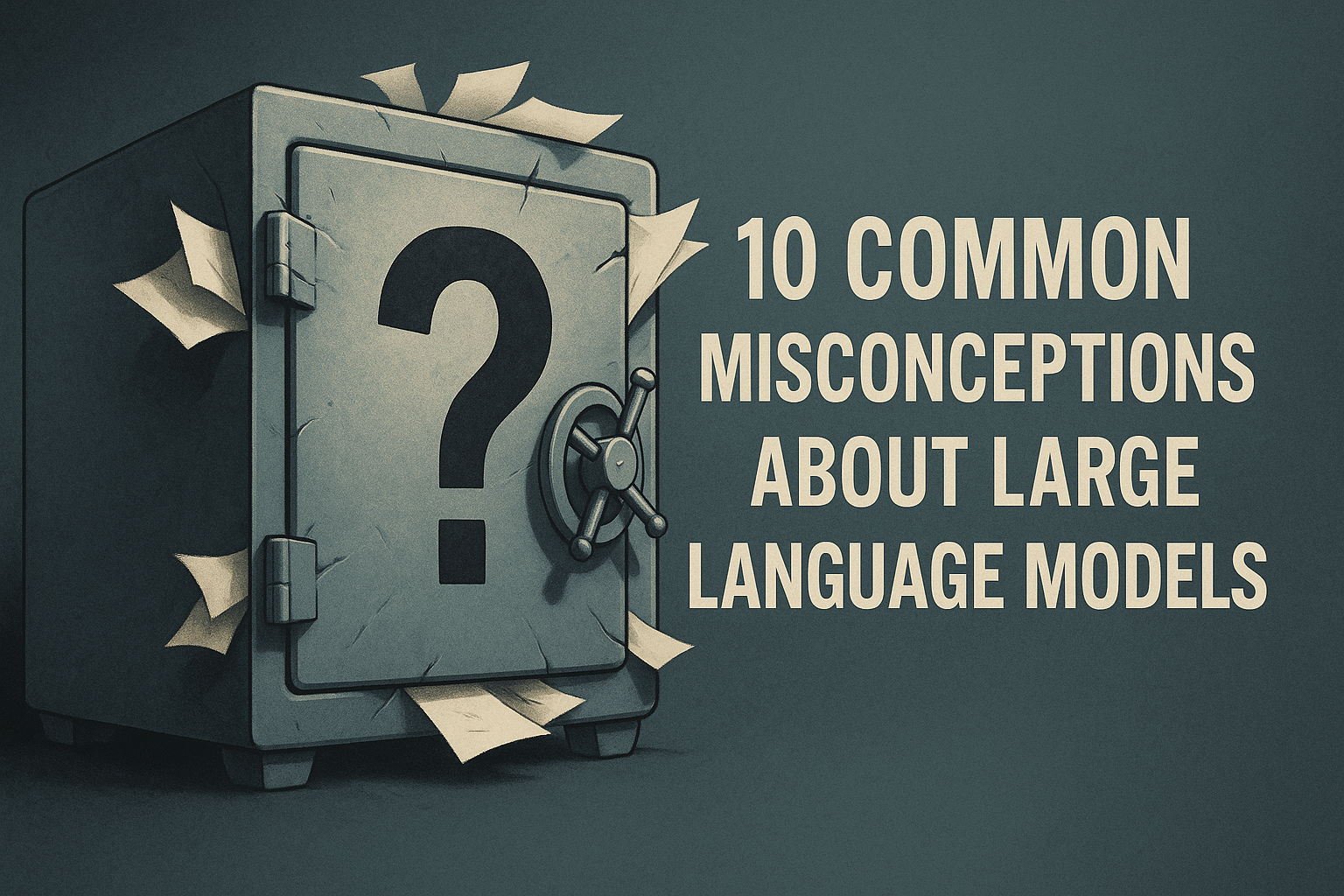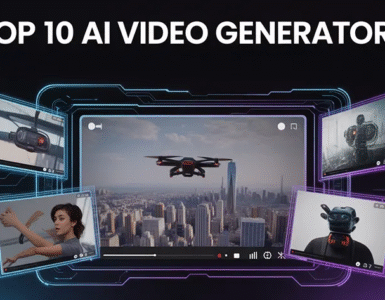
10 Common Misconceptions About Large Language Models
Image by Editor | ChatGPT
Introduction
Large language models (LLMs) have rapidly integrated into our daily workflows. From coding agents that write functional code to simple chat sessions helping us brainstorm ideas, LLMs have become essential productivity tools across industries.
Despite this widespread adoption, fundamental misconceptions persist among both current users and developers planning to build LLM-powered applications. These misunderstandings often stem from the gap between marketing promises and technical reality, leading to poor architectural choices, misallocated resources, and project timelines that don’t account for the models’ actual capabilities and constraints.
Whether you’re integrating an LLM API into your existing product or building an entirely new AI-powered application, understanding what these models can and cannot do is essential for success. Clear expectations about LLM capabilities directly influence how you design systems, structure your development process, and communicate realistic outcomes to stakeholders.
This article covers the ten most common myths about LLMs that every developer should understand before their next AI integration.
1. LLMs Actually Understand Language Like Humans Do
The reality: LLMs operate as advanced statistical engines that match input queries to learned textual patterns. While their outputs appear intelligent, they lack the conceptual understanding that characterizes human comprehension.
When an LLM processes “The cat sat on the mat,” it’s not visualizing a feline on a piece of fabric. Instead, it’s leveraging statistical relationships learned from billions of text examples. The model recognizes that certain token sequences commonly appear together and generates responses based on these learned patterns.
This distinction matters when building applications. An LLM might perfectly handle “What’s the capital of France?” but struggle with prompts that require connecting disparate pieces of information in ways that might not have been common in training data.
So always design your prompts and system architecture appropriately. Use explicit context and clear instructions rather than assuming the model “gets it.”
2. More Parameters Always Mean Better Performance
The reality: Parameter count is just one factor in model capability, and often not the most important one.
The industry’s narrative on large parameter counts associated with super capable language models is not always correct. Training data quality, architectural improvements, and fine-tuning approaches often matter more than raw size.
Small language models are proving this point dramatically. Models like Phi-3 with 3.8B parameters can actually perform better than much larger models on specific reasoning tasks. Code-focused models like CodeT5+ achieve impressive results with relatively modest parameter counts by training on high-quality, domain-specific data.
The efficiency gains are substantial too. Smaller models require less memory, generate tokens faster, and cost significantly less to run. For many production use cases, a well-trained 7B parameter model provides better value than a 70B parameter model that requires expensive GPU clusters.
Choose models based on your specific use case, not marketing claims about parameter counts. Benchmark smaller, specialized models against larger general-purpose ones. Also consider the total cost of ownership, including inference and infrastructure costs.
3. LLMs Are Just Autocomplete on Steroids
The reality: While autocompletion is part of how LLMs work, they exhibit emergent behaviors that go far beyond simple text prediction.
Yes, language models predict the next token based on previous tokens. But this process, when scaled up with transformer architectures and massive datasets, produces capabilities that weren’t explicitly programmed: reasoning through multi-step problems, translating languages, writing code, and even demonstrating some forms of mathematical reasoning.
These emergent abilities arise from the complex interactions between attention mechanisms, learned representations, and the sheer scale of training. The model learns to represent concepts, relationships, and even abstract reasoning patterns — not just word sequences.
Continue working on well-crafted and specific prompts. Experiment with chain-of-thought prompting, few-shot examples, and structured outputs to get the most out of LLMs.
4. LLMs Remember Everything They’ve Learned
The reality: LLMs don’t have perfect recall and can exhibit surprising knowledge gaps.
During training, models see each piece of text only a few times, and there’s no guarantee they’ll retain specific facts. Knowledge is distributed across millions of parameters in ways that don’t map neatly to human memory. An LLM might know obscure historical facts while missing basic information that was underrepresented in training data.
This creates the uncanny valley effect where models seem omniscient in some areas while displaying glaring blind spots in others. The knowledge is also “compressed” — details get lost, and the model might confidently generate plausible-sounding but incorrect information.
Always verify critical information from LLM outputs. Implement retrieval-augmented generation (RAG) for factual accuracy, especially in domains where precision matters.
5. Fine-Tuning Always Makes Models Better
The reality: Fine-tuning can improve performance on specific tasks but often comes with significant tradeoffs.
Fine-tuning typically improves performance on tasks similar to the fine-tuning data while potentially degrading performance on other tasks — a phenomenon called catastrophic forgetting. If you fine-tune a model on legal documents, it might become worse at creative writing or technical explanations.
Moreover, fine-tuning requires careful data curation, computational resources, and expertise to avoid overfitting. Many developers would benefit more from better prompt engineering, retrieval systems, or using pre-trained models that already align with their needs.
Consider prompt engineering, in-context learning, and RAG before jumping to fine-tuning. When you fine-tune, maintain evaluation benchmarks across different task types to catch performance degradation.
6. LLMs Are Deterministic: Same Input, Same Output
The reality: LLMs are inherently probabilistic and introduce controlled randomness during generation.
Even with temperature set to 0, many LLMs still exhibit some non-determinism due to floating-point arithmetic, parallelization effects, and implementation details. At higher temperatures, the model samples from probability distributions, making outputs genuinely unpredictable.
This probabilistic nature is actually a feature, not a bug. It facilitates creative applications, prevents overfitting to specific phrasings, and makes interactions feel more natural. However, it can be problematic when you need consistent outputs for testing or production systems.
Design systems that can handle output variability. Use structured output formats, implement output validation, and consider using lower temperatures or constrained generation when consistency matters.
7. Bigger Context Windows Are Always Better
The reality: Large context windows come with computational costs, performance degradation, and practical limitations.
A 128k token context window sounds impressive, but adding more context doesn’t always lead to better outputs (counterintuitive as it may seem). When processing lengthy contexts, however, language models systematically underperform at accessing information located in middle sections — a problem researchers call “lost in the middle.” This limitation reveals fundamental constraints in how these systems handle extended textual inputs. Also, longer contexts require more compute, increase latency, and cost more to process.
For many applications, smart chunking strategies, summarization, or retrieval systems provide better results than stuffing everything into a massive context window. The key is matching context length to your actual use case, not maximizing it.
Profile your applications to understand where information gets lost in long contexts. Consider hybrid approaches that combine retrieval, summarization, and focused context windows rather than relying solely on large contexts.
8. LLMs Can Replace Traditional Machine Learning for All Language Tasks
The reality: LLMs are great at many tasks but aren’t always the optimal solution for every natural language task.
For high-throughput, low-latency applications like spam filtering or sentiment analysis, smaller specialized models often perform better and cost less. Traditional approaches like TF-IDF with logistic regression can still outperform LLMs on certain classification tasks, especially with limited training data.
LLMs are useful when you need flexibility, few-shot learning, or complex reasoning. But if you have a well-defined problem with plenty of labeled data and strict latency requirements, traditional machine learning techniques might be the better choice.
Evaluate LLMs against simpler baselines for your specific use case. Look beyond accuracy when evaluating performance; factor in costs, response times, and how much work the system requires to maintain.
9. Prompt Engineering Is Just Trial and Error
The reality: Effective prompt engineering follows systematic principles and measurable techniques.
Good prompt engineering involves understanding how models process information, using effective prompting techniques like chain-of-thought and tree-of-thought reasoning, providing clear examples, and structuring inputs to match the model’s training patterns. It’s a skill that combines domain knowledge, understanding of model behavior, and systematic experimentation.
Using techniques like few-shot prompting, defining clear roles, and setting specific output formats will give you much better results. The best prompt engineers develop intuition about how to communicate effectively with language models. It’s closer to a skill than to random guessing.
Invest time in learning prompt engineering systematically. Be sure to document what works and build reusable prompt templates for common tasks.
10. LLMs Will Soon Replace All Software Developers
The reality: LLMs are powerful coding assistants, but software development involves much more than writing code.
While LLMs can generate impressive code snippets and even complete programs, they often struggle with system design, understanding complex business requirements, debugging production issues, and maintaining large codebases over time. They also can’t navigate organizational dynamics, make architectural decisions, or understand user needs.
Current LLMs work best as productivity multipliers — helping with boilerplate code, documentation, test generation, and code explanation. They’re excellent junior pair programmers but can’t replace the judgment, creativity, and system-level thinking that experienced developers bring.
Try using LLMs as tools for accelerating development workflows. Focus on learning how to effectively collaborate with AI assistants and try using agentic AI workflows to speed up development rather than worrying about replacement.
Conclusion
These misconceptions have practical consequences for development teams. Understanding both what LLMs can and cannot do leads to better architecture decisions, more accurate resource planning, and higher project success rates.
Effective LLM implementation requires treating these models as sophisticated tools with specific use cases rather than universal solutions. This means designing systems that account for their probabilistic outputs, planning around their known limitations, and applying them where their strengths align with your needs.
As LLM technology continues to advance, basing your decisions on the models’ actual capabilities rather than marketing claims will result in more reliable and maintainable applications. Focus on matching the right tool to the specific problem rather than retrofitting every challenge to fit an LLM approach.
Source link






































Add comment